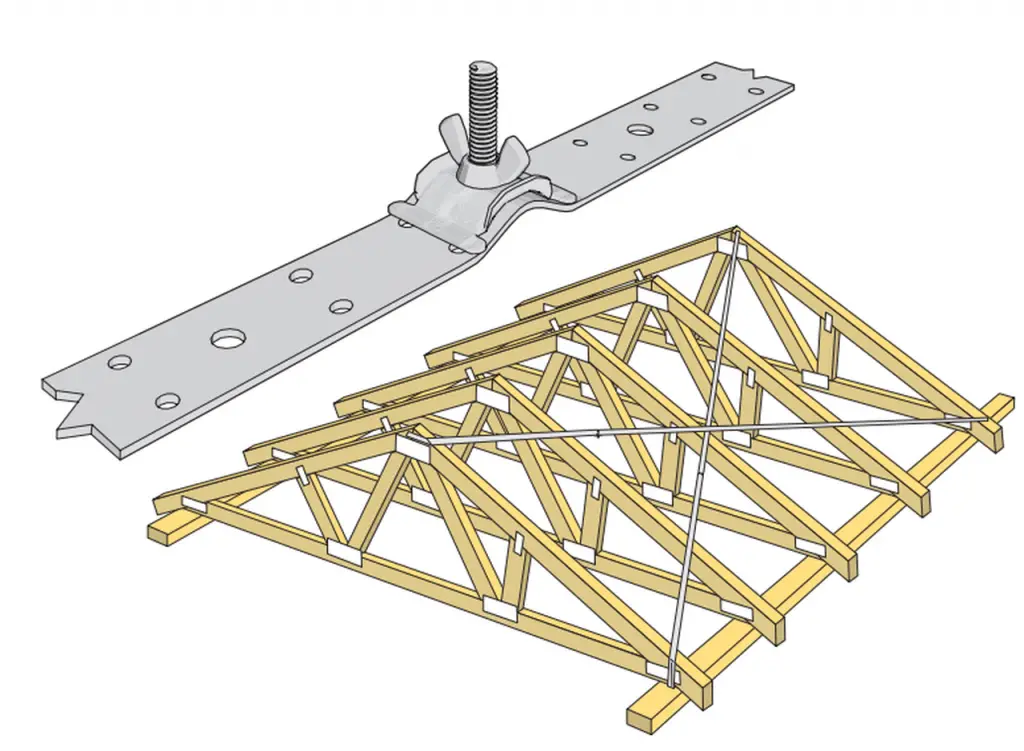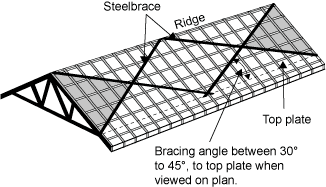Bracing Roof Trusses | Bracing Roof Rafters | Roof Sarking | Cross & Chevron Bracing Roof Trusses
Bracing Roof Trusses | Bracing Roof Rafters | Roof Sarking | Cross & Chevron Bracing Roof Trusses
What is Bracing Roof Trusses?
A bracing roof truss is a structural support for the roof of your home. It helps to maintain the integrity of your roof and reduce the risk that it will collapse during an earthquake, storm, or other natural disaster.
The way in which these brackets are installed depends on whether you have a cathedral ceiling or a pitched roof.
If you have a pitched roof then they would be attached directly to the rafters from below, while if you have a cathedral ceiling then they would be attached above but inside of where your joists are located.
A typical installation includes adding plywood over top of each bracket and securing it with screws so that it can’t shift out of place when there’s heavy snowfall or high winds. This protects against rot and makes it more stable.
This type of roof trusses should be installed in the center of each rafter with a top bar connecting the brace to the rafter.
In some regions, like California, it is required that certain types of roof trusses are installed in every residence if you live in an earthquake zone.
In most cases this means that you can install a roof trusses only for your attic but not on any side walls or Garage rafters.
A roof truss is a set of strong horizontal and vertical beams that are designed to support the weight of the roof.
The two most common types of roof trusses are “brace” and “purlin“. Brace roofs have an I-beam shape with diagonal cross braces running from one side to another.
Purlin roofs use a series of parallel, longitudinal members called purlins that run perpendicular to the rafters or joists.
What is Main Purpose of Bracing Roof Trusses?
Bracing roof trusses is a process that helps maintain the integrity of roof trusses by securing them to the rafter.
Bracing can be done with eave, ridge, or other trusses, and can be accomplished with various types of ladders, scaffolds, or roof brackets.
The objective of bracing is to prevent the roof trusses from splitting or rotating in what is called a “hinge zone”.
Bracing roof trusses is a way to provide lateral stability to a building’s skeleton in order to prevent distortion and collapse.
The purpose of a roof truss is to provide a strong, rigid, and lightweight structure over an area of the home to support the roof load.
Roof joints which are unfastened or not braced can lead to cracking and eventual collapse. Bracing these joints strengthens the joints from movement or vibration.
Wind Bracing Roof Trusses
The wind bracing roof is a creative design for roofs that will ensure that your roof will not be blown away in a storm or heavy winds
A large sheet of plywood or cedar is added to the bottom of the outside of the roof, against the ground.
The board is positioned so that the inside edge is about two inches away from the wall, and then a piece of lumber is attached perpendicular to the board for the roof to rest on.
The board is nailed into place then some shingles are installed in a dotted pattern around the board to cover any gaps.
When the wind blows, or when tiles are shaken from being walked on, the lumber of the bracing board holds the tiles in place as they fall.
The best way to ensure that your roof remains intact after a storm is to have strong, sturdy roof trusses in place.
Roof trusses are large beams that form the skeleton of your roof, and also help to support it. Footers are put into the ground and wood is attached to them for the purpose of keeping your roof upright.
Chevron Bracing Roof Trusses
Chevron bracing is required to guarantee stability on duopitch roof spans over 8m and monopitch roof spans above 5m.
Braces do not have to be overlapping along the roof, and one or two trussed rafters can be left between the ends of adjacent braces.
Braces should be fastened to at least three trussed rafters at a 45-degree angle.
Roof Sarking
Roof sarking is a flexible laminated membrane used beneath tiles to preserve the roof’s structural components. Depending on the company, it is a membrane made of various materials such as polystyrene, reflective foil, or felt.
However, if it comprises foil, it can reflect heat while also performing its other duties. It is used during the roof installation process before the tiles are installed.
Sarking serves as a second, protective skin for the roof beneath the roofing tiles, preventing rain and other elements from reaching the sheathing and beyond.
It is acceptable to exclude rafter diagonal bracing, chevron bracing on webs, and longitudinal bracing at rafter level where approved sarking materials are directly fixed to the top face of the rafter elements.
The sarking/sheathing material must be moisture resistant and give enough resistance to out-of-plane buckling and wind forces.
Bracing Roof Trusses FAQs
1. What is the purpose of roof bracing?
Roof trusses are braced using Roof Bracing to prevent buckling or rotation when subjected to high winds or loads. The pattern of the Roof Bracing is determined by both the span of the roof and the structure of the roof.
2. What are the Functions of Roof Bracing?
Roof bracing performs three distinct functions:
- Temporary bracing: This is used to restrain the trusses during erection.
- Truss Stability bracing: This is permanent bracing which holds the trusses upright, straight and prevents any out of plane buckling of the members.
- Wind or wall bracing: This bracing is installed in the roof in addition to the truss stability bracing and its purpose is to stabilize the gable walls under the action of wind loading.
3. Why are trussed rafter roofs braced?
To form a robust and strong roof structure, trussed rafters must be braced. If the bracing is omitted, incorrectly positioned, or improperly secured, it may cause distortion or failure of individual trusses or, in rare cases, the entire roof.
4. What exactly is the function of roof sarking?
Sarking is a malleable membrane that acts as a second skin for your roof tiles. It improves the efficiency of insulation and protects your valuables from storm-driven rain and dust, moisture, and bushfire ember attack.
Do roof trusses need bracing?
Unless appropriately braced, all trusses are laterally unstable. The longer the lifespan, the more attention is necessary. Restraint is required at all stages of construction. Complete stability is not obtained until the bracing and decking are fully installed and securely secured.
Roof Truss Bracing Diagram
Bracing Roof Rafters
Roof Bracing Types
Steel Roof Bracing
Cross Bracing Roof Trusses



